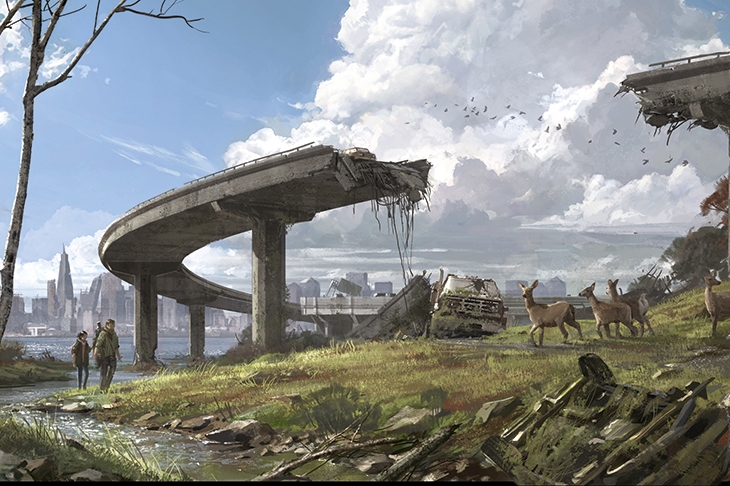For the past few decades, admirers of video-games have every couple of years mounted a new attempt to persuade the wider arts-loving public of the form’s merits. Look, they say, games are not all about shooting people in the face! They are a dynamic fusion of animation, architecture, intellectual challenge, music and drama! They can be political and subversive! This is true, and yet somehow it never catches on. Will a new exhibition at the V&A enjoy any greater success?
You walk through a series of large black rooms with giant screens that appear to be floating through the air. Along the walls are ranged game designers’ working notebooks, and concept art for the characters and landscapes, beautifully rendered in inks and watercolours. This emphasises well the sheer quantity of expert craft that goes into a modern game, while carefully eliding problematic elements. One room, for example, is dedicated to a game called The Last of Us, and foregrounds that game’s quasi-cinematic world-building and clever AI. The giant footage reel, however, neglects to portray the fact that, at heart, the game is primarily a state-of-the-art murder simulator that requires the player to kill more or less everyone she sees from the very beginning.
Indeed, by way of a slogan the exhibition — curated with evident passion and attention to detail by Marie Foulston — has a series of imperative verbs that includes ‘Disrupt’, ‘Collaborate’ and ‘Design’, but not ‘Shoot’. Or, for that matter, ‘Kill With a Giant Axe’, which would be appropriate for Bloodborne, a game rightly celebrated for the fantastically bleak grandeur of its hellish cityscape. The game’s director, Hidetaka Miyazaki, told his crew: ‘Consider the deep sorrow of a magnificent beast doomed to a slow and endless descent into ruin.’ The game does indeed invite you to consider that, before hacking the sad beast to death with rusty steel.
A contrasting exhibit is Nintendo’s gaily coloured Splatoon, in which instead of shooting bullets into people’s eye sockets the player shoots coloured ink over the landscape. Perhaps in an attempt to demonstrate cultural ‘relevance’, the exhibit goes big on the game’s ‘street style’, which means that you can dress your character in a variety of baseball caps and expensive trainers. The opinions of parents subsequently pressured to buy the same apparel in real life are not here solicited.
Better adverts for the videogame as vehicle of artistic expression are the lower-budget indie offerings also exhibited here. The gorgeously meditative Journey has the player skating over sand dunes and through mysterious buildings in a saturated ochre-and-red landscape. The Graveyard is a peculiarly affecting black-and-white micro-game whose objective is to help an elderly woman sit down on a bench.
The exhibition as a whole becomes a lot more interesting, indeed, once it focuses on such arthouse and experimental games. A whole room on videogames as political interventions, in particular, highlights the developers making games that critique the mainstream industry’s overwhelming and long-standing sexism and obsession with violence. On a big screen featuring interviews with luminaries from the digital arts, the artist Robert Young says: ‘We need games that are about dark candlelit dinners, about holding someone’s hand.’ His own contribution is an amusing reversal of gender objectification in games: the player lurks in a steamy locker room until a hunk appears, to be soaped down under the shower. But gratification is not instant: a clock counts down until the next hunk is scheduled to appear. I saw that there were still 35 minutes to go, and regretfully moved on.
All this is very serious and interesting, but the final room is a simple explosion of joy. It is like the arcades of my misspent youth, but these cabinets are from the DIY or ‘punk’ arcade scene. Breakup Squad is a hilarious cartoon game in which two former lovers try to hook up while their friends try to prevent another tedious rapprochement. Enviro-Bear 2000 lets you, a bear, drive a car through a lo-fi forest to grab food, and has a dedicated button to let you roar, which is pointless but very satisfying.
Perhaps the most sarcastic, and funny, game in the whole exhibit is the completely absurd QWOP, in which you must use the titular keys to control a track athlete. Unfortunately, you are given specific control over each leg and calf, which makes perambulation at any speed near-impossible. I was proud at having guided my runner a whole metre before he fell over. Is this high culture, of the kind that pointy-headed art-world gatekeepers might eventually take seriously? No. But it is play in its purest form, and the world could do with more of that.






Comments